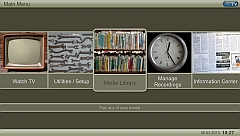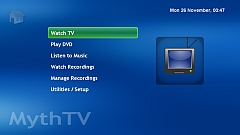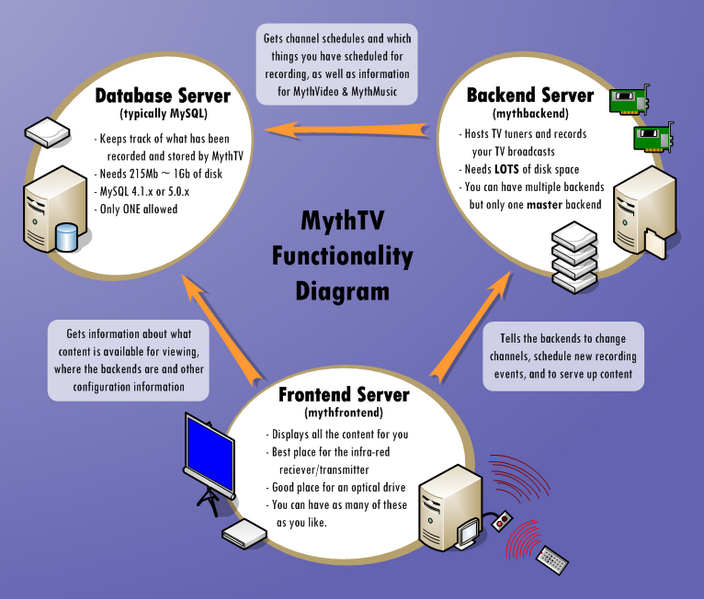Home Theatre PC-base Entertainment System (HTPC)

Fig 1 Typical 1st Screen with Menu Options

Fig 2 An Alternative Theme
Over-Arching Objective
- There was an alternative "agenda" in pursuing the HTPC project and that was to have an "inducement" by which the general populace would be encouraged to learn about the wonders and benefits of Open Source Software. (To learn more see our "About" page. and Project Nicaea.) At the centre of the HTPC is a software application called MythTV.
- Places where you can learn more, try it out and support the projects.
If you would like to learn more about this package or use it, you can download a complete installation for a PC at the MythBuntu site. MythBuntu is actually a collaboration between two large and vibrant project teams. One is a distribution based upon Debian Linux Ubuntu and the MythTV project. Ubuntu is truly an Open Source Software project in that it vows to forever be free software. Ubuntu earns an income by providing services related to its distribution. It also survives as a result of donations so if you have some spare money, I urge you to donate to the project or to use their services. Similarly, if MythTV brings you pleasure, then please help the project in any way you can; and there are many ways!
- MythTV by itself is not for Beginners..
If you are a technical person who loves to dabble then the MythTV site is for you. If you simply want to enjoy this package then I strongly recommend the MythBuntu site. The biggest problem with this application is the MySQL database that it uses. It has to be set up properly. Otherwise the application has no chance of working. This can even happen when doing periodic routine updates! Unskilled users of MythTV have, over the years, had many problems with this database. It is pity that MythTV did not utilise a true Open Source Software database like FirebirdSQL which is far easier to install and use. The good news is that, over the years, this package has become easier and easier to install and use.&dnbsp; As I've indicated, that wasn't always the case. So if you've tried it before and failed to get it working, you might like to try downloading the latest MythBuntu and trying again. If you are going to use either package you should make sure you have a tuner card that is supported by Linux. You can find out more about this by going to http://linuxtv.org/wiki/index.php/DVB-T_PCI_Cards. I so far have not found any manufacturer that goes out of their way to support Linux in the same way they do Windows. This is a pity. The first one to do so will capture a large emerging market and most probably induce other manufacturers to follow.
General
- Overview.
The HTPC provides a low cost High Definition digital TV capable of recording many channels of free-to-air TV at the same time. As mentioned, the system is totally based on the Ubuntu Linux Operating System and an Open Source Application called MythTV. It typically comes with a high quality surround sound system and so produces excellent "theatre-like" quality sound. The system is also to be capable of performing a wide range of tasks associated with home entertainment such as:
- Playing Video DVDs and CDs
- Playing high fidelity surround sound music downloaded from the Internet or on commercially available media like CDs
- Providing Internet Telephony.
- Providing news services.
- Providing a full range of common applications one would expect of a home PC such as:
- web-browsing (using any one of a number of popular browsers such as Chrome & Mozilla)
- email (using Thunderbird or Evolution)
- office suite applications (using LibreOffice) to
provide a:
- wordprocessor,
- spreadsheet,
- drawing package,
- presentation package, and
- database
- All-in-one Solution for Home Units and Holiday Resorts. Whilst being useful in the everyday home, the HTPC, because
it packs so many features into one appliance, is seen as being
particularly useful in townhouses and units where space is at a
premium. For reasons that will be explained in a moment, it would also be useful in Motels, Hotels and Holiday Resorts. One of the attractions of this "all-in-one" system was
that it would remove the need to have a large number of confusing and
difficult to use remote controls. Instead the system would be
controlled using a keyboard and mouse pad to navigate through and
select from easy to understand on-screen menus.
A Frontend and Backend to MythTV

Fig 3 Network Topology for MythTV
Courtesy of http://www.mythtv.org/
- Fully-developed Topology(not normally used in a home). I briefly mentioned above that MythTV, professionally installed and configured, could be very useful in Hotels, Motels and Resorts. That's because it can be set up to have a backend and a front-end and even a separate file server (though normally you would have the database server and the backend TV receiver/video-storage on the same PC). See Figure 3 - courtesy of http://www.mythtv.org/.
- Purpose of each entity. The back end receives and stores the recordings and, typically, holds the database as this latter facility does not consume much processor power. The frontend displays the stored HD video to a screen.
- Capacity of Backend to Record Multiple Channels and the number of hours of HD video storage possible. Receiving a High Definition (HD) TV signal and storing it, raw, on a disk (set up with RAID 0 which involves sharing the writes between two disks and so being able to achieve, overall, very fast write rates) does not involve a lot of processor power. In 1 hour, a HD TV show will consume about 2.7 Gigabytes of disk space. On that basis, on Linux, a 2 Terabyte disk will hold around 700 hours of HD video. If you are recording, say, 6 free-to-air channels continuously, then you could have almost 110 hours worth of viewing. Obviously, if you have a multi-core CPU on your processor, and sufficiently fast disks, your PC could also, in background, compress the data on the drive and so the number of hours that can be stored can easily double.
- Storing past programs very useful for travelling guests. The capability to store almost a week's worth of continuous free-to-air TV can be very handy when applied to business of providing holiday accommodation. For example, when guests who have been travelling come to a resort, they could look at previous shows they had missed whilst in transit. It is possible for a modest PC fitted with two cards, each with four receivers (tuners) to tape 8 free-to-air channels in High Definition. For a card capable of this, you might consider the DigitalNow Quad DVB-T Receiver as it seems to have reasonable Linux support. Unfortunately, the manufacturer has so far not made a suitable driver installer so that a non-technical person can easily insert a driver for this card.
- Sensitivity of Cards.
You should note that many cards require you have a high-gain antenna and be in a good area for reception. Sensitivity is a real issue with many Digital Video Broadcast Terrestial (DVB-T) cards. Recently, as part of an Optus Package, I was given a MeTV box. It is much easier to set up than a MythTV but its menu system and method of control is not the best; especially for those folk who are not "wired-into" this new technology. Most importantly of all, the receiver sensitivity on MeTV is lousy and so it is not possible to obtain even the ABC with any reliability in the area where we live (about 30 kms from the centre of Sydney!). The WinFast and Hauppauge Cards that I use and experiment with in my MythTV installations perform much better. But I digress....
- There can be many frontends served by one backend.
Importantly, depending on the ability of your backend to handle network I/O, there can be a large number of frontends, ie, one in every room in the hotel. Frontends display the video to the users. Depending on the video card being used, this can be quite processor intensive. This isn't a problem though, because the frontend only has to display one program at a time. It's not consumed by laying down the video on a disk drive and possibly compressing the data so as to make better use of the available diskspace.
- Graphics Cards - an essential element for smooth viewing. When choosing a video card, the first issue is whether or not to have a fan. In living areas, fans clog up with carpet lint and general dust. They are also noisy and so are to be avoided if possible. Unfortunately in order to get the power necessary for smooth video, there is a lot of pressure on you to buy a High Powered Graphics card with a fan. Avoid this if you can! The best Graphics cards we have found, up to this point in time, have been nVidia; in terms of their power and the fact you can find an nVidia card that performs satisfactorily without the need for a cooling fan. ATI Radeon cards used to be duds but they are now catching up fast. Something I'm really pleased to see. The nVidia cards use proprietary drivers. If you decide at some point to uninstall the nVidia drivers in order to, for example, use another card, the system will, more than likely not recover from that. When next you start your system, you will have no video whatsoever!! This generally requires you reinstall MythBuntu unless you possess a high level of technical knowledge and are able, in a terminal screen, to clean up the mess that the nVidia setup leaves behind it when uninstalled. The latest ATI Radeon Cards have Open Source Software drivers that work pretty well in terms of speed, and they uninstall without problems. Lately we have found that we obtain acceptable performance out of the ATI Radeon cards but they are still not as good as the nVidia; something that pains me to admit!!
- General comments about hardware. For hardware, we prefer to use low energy AMD processors and ATI Radeon Graphics Cards. For DVB-T cards, we have found that the Hauppauge Brand have given us good service. I would like to try other cards but haven't the time or the money to expend on that aspect of this project at the moment. If I had the time also, I'd like to provide those people who are interested with an easy-to-follow "How-To" to build their own PC system, complete with DVB-T receiver card, and install the MythTV system within a fully-blown Ubuntu (rather than the cut-down version provided by MythBuntu). Up to now, it has been hard work and can be quite frustrating at times. Luckily, I have excellent engineers and friends I can call upon whenever I really get stuck.

